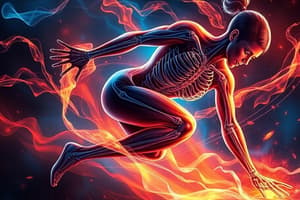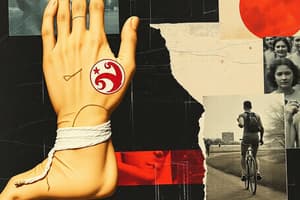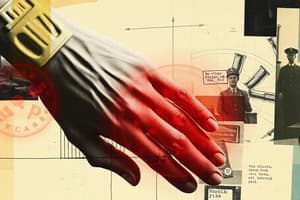Podcast
Questions and Answers
Match the grade of sprain/strain with its corresponding tissue damage:
Match the grade of sprain/strain with its corresponding tissue damage:
Grade 1 = Stretching or microscopic tears in tissue Grade 2 = Partial tear of tissue Grade 3 = Complete tear Normal = No tear
Match the soft tissue lesion with its correct definition:
Match the soft tissue lesion with its correct definition:
Strain = Injury to a musculotendinous unit Sprain = Injury to a joint capsule or ligament Dislocation = Complete displacement of a joint Subluxation = Partial displacement of a joint
Match the phase of soft tissue repair with its primary characteristic:
Match the phase of soft tissue repair with its primary characteristic:
Inflammatory Phase = Damage assessment and initial clearing of debris Proliferative Phase = Initiation of tissue repair through collagen production Remodeling Phase = Strengthening and reorganization of new tissue None = Phase where patient is fully recovered
Match the clinical sign with the corresponding phase of tissue healing:
Match the clinical sign with the corresponding phase of tissue healing:
Match the element of the PEACE acronym with its meaning in acute injury management:
Match the element of the PEACE acronym with its meaning in acute injury management:
Match the element of the LOVE acronym with its role in rehabilitation:
Match the element of the LOVE acronym with its role in rehabilitation:
Match the healing time with the corresponding grade of ligament sprain:
Match the healing time with the corresponding grade of ligament sprain:
Match the following factors with their potential impact on tissue healing:
Match the following factors with their potential impact on tissue healing:
Match the appropriate intervention with the phase of healing each patient is experiencing(16 year-old w/ Grade 1 ATFL sprain 36 hours ago, 40 year-old w/ Grade 2 hamstring strain 2 month ago, 23 year-old strained his back 2 weeks ago):
Match the appropriate intervention with the phase of healing each patient is experiencing(16 year-old w/ Grade 1 ATFL sprain 36 hours ago, 40 year-old w/ Grade 2 hamstring strain 2 month ago, 23 year-old strained his back 2 weeks ago):
Match the additional soft tissue lesions with their correct definition:
Match the additional soft tissue lesions with their correct definition:
Flashcards
What is a strain?
What is a strain?
Injury to the musculotendinous unit.
What is a sprain?
What is a sprain?
Injury to a joint capsule or ligament.
What is a dislocation?
What is a dislocation?
Complete displacement of a joint.
What is a subluxation?
What is a subluxation?
Partial displacement of a joint.
Signup and view all the flashcards
What is tendinopathy?
What is tendinopathy?
Tendon pathology that is affected by mechanical load.
Signup and view all the flashcards
What is synovitis?
What is synovitis?
Inflammation of the synovial membrane.
Signup and view all the flashcards
What is hemarthrosis?
What is hemarthrosis?
Bleeding into a joint.
Signup and view all the flashcards
What is bursitis?
What is bursitis?
Inflammation of a bursa.
Signup and view all the flashcards
What is a contusion?
What is a contusion?
Bruising resulting from trauma.
Signup and view all the flashcards
What does PEACE stand for?
What does PEACE stand for?
Protection, Elevation, Avoid anti-inflammatories, Compression, Education.
Signup and view all the flashcardsStudy Notes
Soft Tissue Lesions
- A strain involves the musculotendinous unit
- A sprain involves the joint capsule and ligaments
- A dislocation means there is complete displacement
- A subluxation involves partial displacement
- Tendinopathy affects tendon pathology and is affected by mechanical load
- Synovitis is inflammation of the synovial membrane
- Hemarthrosis is bleeding into a joint
- Bursitis is the inflammation of a bursa
- A contusion is bruising due to trauma
Grades of Sprain/Strain
- Grade 1 involves stretching or microscopic tears in tissue
- Grade 1 presents with minimal swelling, localized pain and almost normal ROM
- Grade 2 involves a partial tear of tissue
- Grade 2 presents with moderate swelling, bruising, and loss of ROM with significant pain
- Grade 3 involves a complete tear
- Grade 3 presents with severe pain, swelling, bruising and loss of ROM
Healing Times by Grade
- Muscle tissue takes 0-3 days to heal if exercise induced
- Muscle tissue takes 1-4 weeks to heal in Grade 1
- Muscle tissue takes 3-12 weeks to heal in Grade 2
- Muscle tissue takes 1-6 months to heal in Grade 3
- Tendonitis takes 3-7 weeks to heal
- Tendonosis takes 3-6 months to heal
- Grade 1 ligament sprain takes 2-8 weeks to heal
- Grade 2 ligament sprain takes 2-6 months to heal
- Grade 3 ligament sprain takes 6-12 months to heal
- Meniscus/labrum takes 3-12 months to heal
- Fractures take 6-8 weeks to heal
Soft Tissue Repair - Inflammatory Phase
- Involves assessing the damage and clearing out damaged tissue
- Lasts for 4-6 days up to 2 weeks
Soft Tissue Repair - Proliferative Phase
- Involves beginning repairs
- Lasts for 4-24 days, but up to 6 weeks in limited circulation such as tendons
Soft Tissue Repair - Remodeling
- Involves strengthening and completing repairs
- Lasts from 3 weeks to 2 years depending on tissue and grade of damage
Inflammatory Phase - Tissue Response & Characteristics
- Chemical signals such as histamine and bradykinin induce vascular changes and edema
- Chemotaxis draws leukocytes and other immune cells to the area
- Clot formation occurs
- Phagocytosis by leukocytes and macrophages occurs
Inflammatory Phase - Clinical Signs
- Redness, swelling, heat, and pain are present
- Pain occurs before tissue resistance with movement
Inflammatory Phase - Management
- Control stress to the injured tissue, such as with protection
- Reduce swelling
- Control the inflammatory response, but do not interfere with it
- Use pain as a guide
PEACE Acronym
- Protection: avoid activities那that increase pain during the first few days after injury
- Elevation: elevate the injured limb higher than the heart as often as possible
- Avoid anti-inflammatories: taking anti-inflammatory medications and icing can reduce tissue healing
- Compression: use elastic bandage or taping to reduce swelling
- Education: let nature play its role and avoid unnecessary passive treatments and medical investigations, since your body knows best
Proliferative Phase - Tissue Response & Characteristics
- Growth of capillary beds occurs
- Type III collagen formation
- Granulation tissue forms
Proliferative Phase - Clinical Signs
- Pain is synchronous with tissue resistance during movement
- Inflammation signs are decreasing
Proliferative Phase - Management Considerations
- Continue controlled stressing of tissues
- ROM, intensity, and frequency can be progressed
- Target restrictions
- The tissue is still fragile, therefore avoid quick, explosive stressing of tissue
- Use pain as a guide
LOVE Acronym
- Load: pain should guide the gradual return to normal activities, and your should tell you when it's safe to increase load
- Optimism: condition your brain for optimal recovery by being confident and positive
- Vascularisation: choose pain-free cardiovascular activities to increase blood flow to repairing tissues
- Exercise: adopt an active approach to recovery to restore mobility, strength, and proprioception
Remodeling Phase - Tissue Response & Characteristics
- Maturation of scar tissue occurs
- Contracture of scar tissue
- Remodeling of Type III collagen to Type I
- Collagen aligns to stress
Remodeling Phase - Clinical Signs
- No inflammation signs
- Pain during movement occurs at end-range tissue resistance
Remodeling Phase - Management Considerations
- Progressively stress the tissues
- Increase volume, load, and intensity
- Incorporate rapid, quick, power movements
- Progressively return to the prior level of function
- Avoid pain but be aware that discomfort is normal when pushing limits
Factors That Affect Healing - Lifestyle
- Diet
- Activity levels
- Smoking and alcohol
- Stress
Factors That Affect Healing - Comorbidities
- Age
- Obesity
- Diabetes
- Immunocompromised conditions
Studying That Suits You
Use AI to generate personalized quizzes and flashcards to suit your learning preferences.




